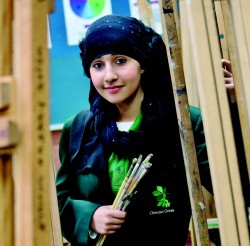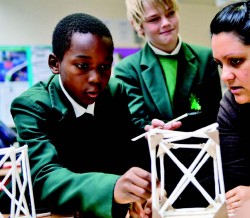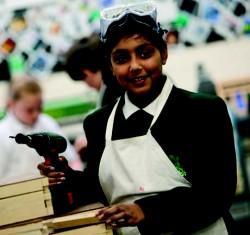
Although students, a high proportion of whom had special needs and challenging behaviour, made good progress (which we measured even then, even if the Dfe didn’t), this didn’t translate into high percentages of A-C grades.
What Chestnut Grove did have, however, was something very special: an amazing art department. Sculptures, paintings, pots and prints from the Victorian print-making machine pervaded the school, links with London Art Colleges were strong, and many students from the small sixth form went on to study fine or applied art.
When specialist schools were introduced, therefore, we saw that with the additional resources this would provide, we could develop the arts even further and, most importantly, use the special nature of the arts and the established excellence and rigour of its teaching in the school to drive up standards in all the other departments.
In 2008, the Ofsted inspector who judged the school outstanding recognised the arts as an important factor in the school’s success. Not only does Chestnut Grove shout creativity from its displays of students’ work, but our ethos itself has been moulded by it over the years. The culture of the school, taking its lead from the arts, has become increasingly forward-looking and innovative, imaginative in its problem-solving and direction. Creativity and high expectations feed off each other.
From the beginning, we introduced a week-long arts festival, with a suspended timetable and the whole school community working in cross-curricular teams to create art in all its forms, usually around a theme – the Olympics for example. This hive of activity not only unleashes the imagination of staff and students, but gives time and space to explore and develop work in ways which are not possible in one hour slots. Our experience of the depth this allows had another off-shoot; some years ago, we decided to extend the week into what we call our ‘summer timetable’, when we re-organise the days into bigger ‘chunks’ of time to encourage imaginative teaching and deep learning.

However, the creative culture of the school has never been limited to art, drama, dance and music – though these have all become very strong over the years – or to the arts festival week. We believe that creativity is integrally linked to the development of understanding, critical thinking and deep learning and there are numerous examples of this across the curriculum. One example of this is the use of ‘model-making’ to promote understanding of complex knowledge – plant cells or the flow of blood in Science; drainage basins in Geography; the composition of the orchestra in Music; how the Globe theatre works in English.
Cross-curricular projects also break down the traditional boundaries between subjects, often through the vehicle of art. Art and maths, for instance, worked together on a long-term project bringing together mathematical skills (e.g. tessellation), awareness of how different cultures have used these in their art forms – Islamic tiles, textiles etc. – and students’ own creativity in making their own.
The maths department has also worked with design technology to teach forces through bridge-building, and English and drama often combine in projects such as ‘Who Killed Mr. X’, (deputy head), when students ‘become’ investigators.
Within individual subjects, teachers promote learning through creativity all the time. In philosophy, beliefs and ethics, students design their own deities and contemporary versions of ‘hunger cloths’; in history they come up with their own ‘coats of arms’ and use film and animation to present their understanding of, say, ‘the 40s’, and drama to demonstrate their understanding of conditions in the Industrial Revolution.
In citizenship, which is delivered through imaginative whole days, students develop different kinds of creativity – for example designing and promoting their own campaign, this year based on a Robin Hood tax, thereby increasing their understanding of economics as well as how to express themselves to persuade others, and, of course, having a great deal of fun in the process.
Students’ pride in the school has grown immeasurably in the last decade. Learners gaining one of our ‘art specialist places’ on entry to the school proudly wear a badge proclaiming their status. Our community work with local primary schools is still valued even though we now have to fund it ourselves, and we were delighted, in 2011, to be accredited to run the Art Foundation Course for post- A level students. The arts remain very central to all we do.
Everyone who visits Chestnut Grove comments on its atmosphere. It has vibrancy, an energy and a vigour which you can ‘feel’. This might be because of its design, its size, its friendliness or the sound of one of the seven steel pan groups practising for their next tour… but we think it’s also because of the creativity and our long-held belief in the power of the arts.

Shermaine Slocombe, arts college manager at Corelli College, London, explains how a recent whole school creative project in partnership with an artists’ collective has enhanced students’ educational experience
“A creative climate is stimulated when a flexible curriculum is supported and enables an innovative approach to learning. Partnerships with quality, socially engaged external professionals bring specific expertise with new resources and opportunities for both students and staff.
At Corelli we strive for the best of our work to be recognised nationally and contribute to shaping the wider educational debate, which was the aim behind approaching greyworld. Each year we work with a range of creative partners on our whole school Arts Festival designed to inspire learning and raise the profile of the arts within curriculum time. For 2012, we wanted to push the boundaries of creativity and encourage artists to develop their work in new directions. greyworld were the ideal partners as they excel at transforming spaces and encouraging their audience to interact playfully. Temporary public art can be used as a catalyst to challenge, and even change, attitudes and preconceptions especially if the themes are relevant to our everyday lives – this is core to the partnership ethos. The festival in 2012 was designed to accelerate investigative and creative problem solving skills particularly in the E-Bacc subjects in order to provide content and student ownership for the final sculpture.
The modern day oracle that Greyworld created is the proud centrepiece of Corelli’s foyer and is the perfect vehicle for students to enhance their learning experience in an environment where they already enjoy a rich mix of opportunities to see and share their own work. ‘Signs’ is primarily a learning tool for Corelli students; however, we also hope it will act as inspiration for other schools and colleges to enhance the learning experience of their students in an exciting way. The five arms can point to anything on earth from a world or sporting event, even through to more conceptual representations of mathematical solutions, environmental change, students’ ancestry, or imaginary things like future predictions and alternative endings to stories. These themes can be changed and adapted all the time and as a result the piece has an infinite range of places to point to, ideas to suggest and emotions to evoke. This project will inspire students and the community and help break down some common preconceptions about the accessibility of art.”
About the author
Margaret Peacock is head teacher at Chestnut Grove Academy, Balham










